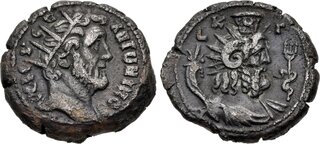| Classical Numismatic Group > Auction 126 | Auction date: 28 May 2024 |
| Lot number: 532 Price realized: This lot is for sale in an upcoming auction - Bid on this lot  | Show similar lots on CoinArchives Find similar lots in upcoming auctions on |
| Lot description: EGYPT, Alexandria. Antoninus Pius. AD 138-161. BI Tetradrachm (24.5mm, 11.96 g, 12h). Dated RY 23 (AD 159/60). ANTƱNINOC CЄB ЄVCЄB, radiate bust right, traces of drapery on left shoulder / Radiate and draped bust of Serapis-Pantheos right, wearing calathus and horn of Ammon; cornucopia over left shoulder, dolphin-entwined trident to right, L K Γ (date) across upper field. Köln 1847 var. (laur. bust left); Dattari 2380 var. (laur. bust right); K&G 35.819 var. (laur. bust left); RPC IV.4 2147 var. (laur. bust left); Emmett 1435.23 (R5). Dark gray patina, light roughness. VF. An unpublished variety of an already extremely rare type. From the Dr. Thomas E. Beniak Collection, purchased from Holyland Numismatics, 8 January 2010. Serapis was a syncretic god, a combination formed from Hellenistic Greek and Egyptian religious concepts. His name is of Egyptian origin and derives from a synthesis of Ausar (Greek, Osiris), the Egyptian god of the Underworld, and Hapi (Greek, Apis), a manifestation of the god Ptah. Under the Ptolemies, Serapis became the chief tutelary god and the subject of a royally-sponsored cult, whose emphasis on an afterlife made the worship of Serapis one of the more popular mystery cults. His immense popularity soon promoted his creation as Serapis-Pantheos, a hybrid deity incorporating other divine elements. In Alexandria, a large temple complex called the Serapeum was constructed that remained highly patronized well into the fourth century AD. Shortly after the imperial decree of AD 391, officially ordering pagan temples closed, the Serapeum was besieged, plundered, and destroyed. Estimate: 500 USD |  |



